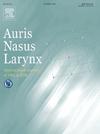Background factors in patients with compensated video head impulse test gain after vestibular rehabilitation therapy
IF 1.5
4区 医学
Q2 OTORHINOLARYNGOLOGY
引用次数: 0
Abstract
Objectives: A few patients with chronic vestibular dysfunction have shown improved video Head Impulse Test (vHIT) gain after vestibular rehabilitation therapy (VRT), whereas others have shown either slight improvement or remained stable. Therefore, we investigated whether some specific factors affected the vHIT gain after VRT. Methods: Six hundred and eighty-six patients with intractable vertigo/dizziness who were hospitalized for neuro-otological examinations at the Vertigo/Dizziness Center of Nara Medical University between July 2014 and October 2023 were enrolled. In addition, patients who had a vHIT gain < 0.8 for the semicircular canal at the time of their first visit to our hospital and had undergone 6 months of VRT were included in the study. Patients were divided into two groups: VRT-C included participants with a vHIT gain of ≥ 0.8, and VRT-R included those with a vHIT gain of < 0.8 after 6 months of rehabilitation. We investigated factors such as age, illness duration, maximum slowphase eye velocity (mSPV) in the caloric test (C-test) for the dysfunctional ear, mSPV in the C-test for the functional ear, subjective visual vertical, ocular vestibular-evoked myogenic potentials, and cervical vestibular-evoked myogenic potentials. Results: Twenty-seven patients were enrolled in this study (21 in the VRT-R group and six in the VRT-C group). The VRT-C group had a shorter illness duration than the VRT-R group (p = 0.0056, Mann–Whitney U test). In the dysfunctional ear C-test, the mSPV was significantly greater in the VRT-C group than in the VRT-R group (p = 0.0205, Mann–Whitney U test). No differences were observed between the two groups in terms of other factors. Conclusion: VRT may improve vHIT gain in patients who can undergo it earlier and those with larger mSPV values in the C-test for dysfunctional ears. However, other studies have identified several factors influencing the effectiveness of VRT. However, further research is required to confirm this hypothesis.
前庭康复治疗后补偿视频头脉冲试验增益患者的背景因素
目的:少数慢性前庭功能障碍患者在前庭康复治疗(VRT)后显示出视频头部脉冲测试(vHIT)的改善,而其他患者则显示出轻微的改善或保持稳定。因此,我们研究是否有一些特定因素影响VRT后的vHIT增益。方法:选取2014年7月至2023年10月在奈良医科大学眩晕中心接受神经耳科检查的686例难治性眩晕/头晕患者。此外,vHIT增加的患者首次来我院就诊时半规管患者为0.8例,并接受了6个月的VRT治疗。患者分为两组:VRT-C组包括vHIT增益≥0.8的参与者,VRT-R组包括vHIT增益为<的参与者;康复6个月后0.8。我们研究了年龄、病程、功能障碍耳的热量测试(C-test)中的最大慢相眼速度(mSPV)、功能障碍耳的C-test中的最大慢相眼速度(mSPV)、主观视觉垂直、眼前庭诱发肌电位和颈前庭诱发肌电位等因素。结果:27例患者入组,其中VRT-R组21例,VRT-C组6例。VRT-C组病程短于VRT-R组(p = 0.0056, Mann-Whitney U检验)。在功能障碍耳c试验中,VRT-C组的mSPV显著高于VRT-R组(p = 0.0205, Mann-Whitney U检验)。在其他因素方面,两组之间没有观察到差异。结论:VRT可改善早期接受VRT的患者和功能障碍耳c试验中mSPV值较大的患者的vHIT增益。然而,其他研究已经确定了影响VRT有效性的几个因素。然而,需要进一步的研究来证实这一假设。
本文章由计算机程序翻译,如有差异,请以英文原文为准。
求助全文
约1分钟内获得全文
求助全文
来源期刊

Auris Nasus Larynx
医学-耳鼻喉科学
CiteScore
3.40
自引率
5.90%
发文量
169
审稿时长
30 days
期刊介绍:
The international journal Auris Nasus Larynx provides the opportunity for rapid, carefully reviewed publications concerning the fundamental and clinical aspects of otorhinolaryngology and related fields. This includes otology, neurotology, bronchoesophagology, laryngology, rhinology, allergology, head and neck medicine and oncologic surgery, maxillofacial and plastic surgery, audiology, speech science.
Original papers, short communications and original case reports can be submitted. Reviews on recent developments are invited regularly and Letters to the Editor commenting on papers or any aspect of Auris Nasus Larynx are welcomed.
Founded in 1973 and previously published by the Society for Promotion of International Otorhinolaryngology, the journal is now the official English-language journal of the Oto-Rhino-Laryngological Society of Japan, Inc. The aim of its new international Editorial Board is to make Auris Nasus Larynx an international forum for high quality research and clinical sciences.
 求助内容:
求助内容: 应助结果提醒方式:
应助结果提醒方式:


